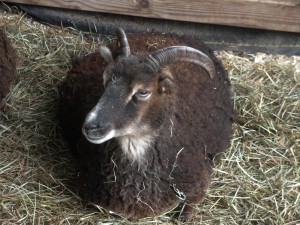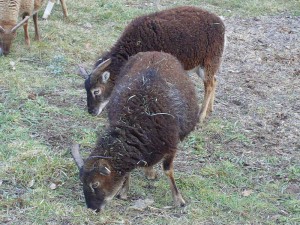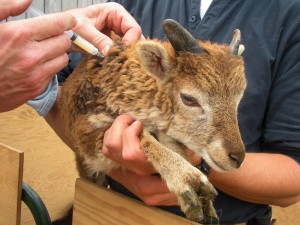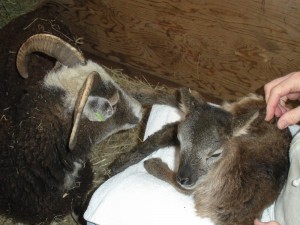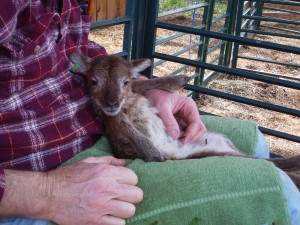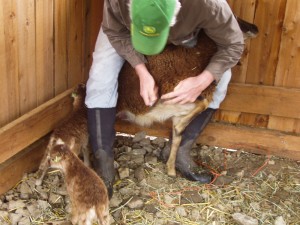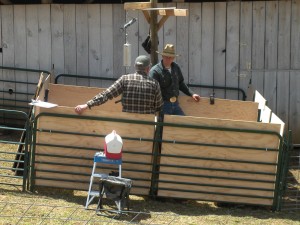Vaccinations and other “shots” for Soay sheep: when, why, and how
Soay sheep are legendary for their hardiness, including their resistance to disease. They don’t need much in the way of vaccinations — just one per year in our experience — but that one annual immunization is important to their good health. As for other shots, a pair of vitamin and mineral injections for newborns will give them a good head start towards a healthy life.
Caveats: neither of us is a veterinarian and we are not familiar with what other immunizations may be needed in other parts of the U.S. or Canada. But we are pleased to pass on what we have learned from the standard sheep husbandry books and articles, from our vets, and from our own experience here in southern Oregon. The best advice we can give, which at this point falls into the broken-record department, is to schedule a sit-down appointment with your local veterinarian to develop a husbandry program to address whatever issues you face in your geographic area. It’s the most cost-effective way, in our opinion, to get your Soay sheep started on the right health track and keep them that way.
Okay, mattresses laid. Here is what has worked for us in our mild four-season climate with hard freezes in the winter and high 90s F in July and August, dry most of the year, good pastures, etc.
One annual vaccination for everyone
We vaccinate all of our sheep — adults and lambs — once a year with one of the commercial vaccines formulated to protect against tetanus and other clostridial diseases and we urge all Soay shepherds to do so as well. We have never lost an animal to a cloistridial disease, but we have been told by another breeder who lost a ram to tetanus that it is a grisly death. I was cautioned as a child about rusty nails — you probably were, too — and in fact the clostridial microorganism causing tetanus enters the animal’s body through a dirty puncture wound. Another clostridial disease is caused when the animal overeats or has an abrupt diet change, ingests the bacteria that are in the soil while it eats, and the bacteria take off in the challenged intestines, producing a disease with the grim-sounding name “enterotoxemia.” And the list goes on. Have I persuaded you to protect your flock against these nasties?
There are two commonly-used vaccines on the market, “CDT” and “Covexin-8.” On the recommendation of our vet, we give each animal a 2cc shot of Covexin-8 once a year (lamb innoculation is in two doses four weeks apart, see below). Although CDT protects against the three biggest threats (tetanus, enterotoxemia, and pulpy kidney) and will work just fine, Covexin-8 includes 5 additional, rarer clostridial elements, so we use it just to be on the safe side. Please note the 2cc dosage is less than the label calls for — Soay sheep are small. CDT and Covexin-8 are thin enough liquids that a 22-gauge needle works for both lambs and adults. We administer the shots subcutaneously; you can certainly do it yourself.
When we first started out with sheep, Steve vaccinated behind the animal’s right front leg, the common way of dealing with larger sheep. We were shown this technique by Kate Montgomery, a legendary early Soay breeder and veterinarian. Injecting behind the leg obviously worked well for Kate with her unusually large (and very handsome, I might add) American Soay sheep. You can see Steve injecting a ewe behind her right leg in an old picture farther down this post. [Newsflash: pictures of sheep shots have not been high on my priority list for photography; I had to scour our files for anything remotely resembling a vaccination picture, sorry].
At some point Steve decided that for our smaller British Soay sheep, the skin behind the leg was too thin and too tight and very hard to pull up into the little “tent” of skin needed need to do a “subQ.” So he switched to injecting slightly ahead of the shoulder. You can see him using this technique in the picture of the cute little tan lamb farther down this post.
Scheduling immunizations
Our pregnant ewes get their annual dose of Covexin-8 about 30 days before lambing to enhance protection for the lambs. It increases the levels of circulating antibody in the ewe’s blood, notably the varieties of antibody that are designed to accumulate in the colostrum in the days just before birth.
In other words, vaccinating late in gestation makes for a more potent colostrum, which in turn makes for healthier lambs.
Lambs
At age ~6 weeks and again at ~10 weeks, we give our lambs their first vaccinations, 2 cc each time, using a very short, half-inch needle. From then on, the lambs are on the same schedule as the adults, once a year starting when the lambs are a year old.
A special word of caution about castrating ram lambs
Tetanus is a particular risk for ram lambs destined to be castrated using the rubber band technique (i.e., castrated while their parts are still small enough to slip through the rubber band). These little guys are extra vulnerable because the decaying flesh in the scrotum is in a low-oxygen, anerobic environment, very much like puncture wounds. When we round up the lambs for their second vaccination at 10 weeks, any ram lambs we know will be castrated at some point, and whose testicles are big enough to band, get their rubber band treatment right then. They have both the protection of their first vaccination and some residual protection from their nursing mothers. If we decide later to band a ram lamb, he will have had the additional protection of his second vaccination at 10 weeks.
Adult rams and non-pregnant ewes
We vaccinate all of our other adult sheep in the summer when it is not so muddy here. This group includes the yearling ewes who do not breed their first year, all of the yearling and adult rams, and any adult ewes we did not breed.
There is no need to vaccinate for anything else in our area. It may be that shepherds in other parts of the U.S. and Canada have sheep-specific diseases that require additional innoculations — check with your vet.
Other advisable shots as preventative measures
On the recommendation of our vet, we also give our newborn lambs two shots within 24 hours of birth: .25 cc of BoSE (a mixture of Selenium and Vitamin E), and .25cc of a combination of Vitamins A & D.
At the same time, we give the ewe 1cc of BoSe to boost her selenium during the critical weeks after lambing.
BoSe is indicated in areas where the forage or hay is selenium deficient. Based on a decade of working with customers and colleagues around the U.S., we are pretty sure that most areas of the U.S. are selenium deficient, but check with your vet and/or your county or state agricultural extension office. These shots are administered subcutaneously also, with one important difference. BoSe and A&D are thick so you need to use a 20g needle at least.
Where do these shots take place? For the lambs, in a dandy jerry-rigged set of temporary corrals made from Shaul panels and plywood. The plywood keeps lambs from trying to jump out to where their mothers are enjoying a brief respite from nursing. If you click on the picture of Steve and Shawn to see it in larger format, you’ll have an easier time noticing the dark shapes under the boards: those are lambs calmly waiting to be worked — the plywood is doing its job.
You may wonder why Shawn and Steve are just standing there amidst the snoozing lambs. We suspect Priscilla had gone off to get something she forgot (probably a marking pencil), or new cups of coffee, leaving The Crew and the lambs to bask in the early summer sunshine. The red and white cooler keeps the pre-loaded Covexin-8 syringes cold. The camp stool is for whoever needs it. The scale and sling are ready for weighing. This must have been a day when we worked 10-week old lambs since it is our larger scale. Over on the left, perched precariously on the corner, is the working list of lambs and what they need done to them. Life is good!
And that’s it for preventative vaccinations and other shots. As in many other aspects of their lives, the heritage Soay sheep really are hardy and don’t need additional protection from a lot of the diseases sometimes found in commercial breeds of sheep.
For more detail about vaccinations and other shots, click on any of these links, one specifically about anti-tetanus vaccinations, or other places on our website where you will find more information about shots for lambs and related treatments, and the mechanics of injections in the context of working newborn lambs.
A closing note of caution: preventing coccidiosis and dealing with intestinal parasites (worms) are entirely separate issues from vaccinating against clostridial disease and boosting your lambs’ (and their mothers’) selenium. Check the menu here and on our farm website for information on cocci and worms.
For now …
